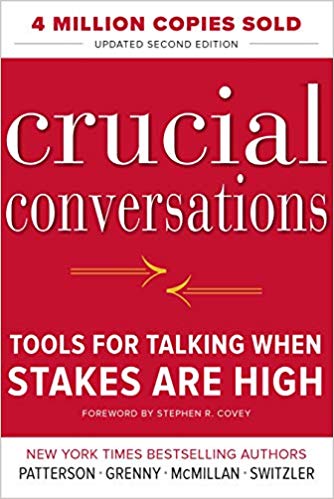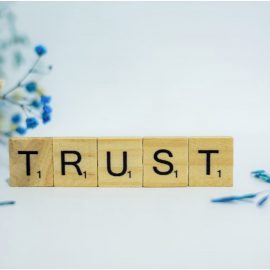

This article is an excerpt from the Shortform summary of "Crucial Conversations" by Kerry Patterson. Shortform has the world's best summaries of books you should be reading.
Like this article? Sign up for a free trial here .
Do you want to know how to have difficult conversations at work? Are there issues you need to address, but you’re not sure how?
Having difficult conversations at work can feel daunting. But having those conversations is important. It will improve your management skills and the organization. Keep reading for examples of difficult conversations at work, and how to resolve them.
Why Should You Have Difficult Conversations at Work?
Having leaders and employees who skillfully handle crucial conversations can improve an organization’s performance, while poorly handled conversations and interactions can undercut it. So while it’s certainly hard to have difficult conversations at work, it’s a skill that benefits the whole group.
When employees have good conversation skills
On the positive side, the authors’ research shows that companies whose employees are skilled at crucial conversations:
- Respond faster to financial downturns.
- Are less likely to be injured due to unsafe conditions.
- Increase the productivity of virtual (remote) work teams.
- Influence misbehaving or incompetent colleagues to do better.
Most leaders think that organizational productivity and performance are driven by policies, processes, or systems. When there are problems they adjust these things, but it often doesn’t work because the problem is behavior, not systems.
Solving behavior problems requires crucial conversation skills, and shows that employees benefit from learning how to have a tough conversation at work.
When employees have poor conversation skills
On the negative side, when organizations have performance problems such as snowballing costs, late delivery times, and poor morale, the biggest reason is employees’ unwillingness or inability to speak up (have crucial conversations) at key moments. These companies have not put the time into learning how to have a difficult conversation at work, and it shows.
For example, employees see others take shortcuts or make mistakes, and don’t say anything, which impacts safety, turnover, and productivity. Also projects can fail when employees stay silent about problems — for instance, when goals are unrealistic, team members perform badly, or leadership stumbles.
How to Have Difficult Conversations at Work: Focus on These Two Things
First, the suggestion: One way people have succeeded in improving their handling of crucial conversations is by focusing on just two key principles: Pay attention to what’s happening, and ensure safety. These principles are universal in crucial conversations, and they can be applied when you’re figuring out how to have a difficult conversation at work.
1. Pay attention to what’s happening: Constantly ask yourself whether you’re in or out of dialogue. This makes a huge difference.
Even if you can’t remember the acronyms or steps you can help maintain dialogue by noticing whether you or others are falling into silence or violence. Even if you don’t know exactly how to fix the problem when you see it, it’s worth trying something to restore the dialogue.
You can use the statement, “I think we’ve moved away from dialogue,” to get back on track.
2. Ensure safety: When you notice that you and others have moved away from dialogue, do something to make it safer — for instance, asking a question and showing interest in others’ views.
Just do something to make others comfortable: smile, apologize if you’ve moved to silence or violence, or request a brief timeout. Although the book suggests specific skills (such as contrasting, mirroring, priming), there are many other things you can do to increase safety.
People often think their situations are unique and that dialogue skills outlined in this book don’t apply, or won’t work. According to the authors, the skills do in fact apply to virtually any issue, although some problems are more challenging than others.
Example of Difficult Conversations at Work
What’s next in learning how to have a tough conversation at work? Difficult conversations at work take many forms, but some are a little more complex than others. Below are examples of difficult conversations at work and how to resolve them.
Difficult Conversation Example #1: Harassment
You’re uncomfortable with the way you’re being treated, although you don’t view it as blatant harassment.
Challenge
You find the behavior offensive, but it’s so subtle or sporadic that you’re hesitant to go to your boss or HR for fear of looking like you’re overreacting. Getting caught up in a villain story could drive you to respond in ways that end up hurting you.
Solution
Tell the full story. Admit it if you’ve put up with the behavior for a while without saying anything. Then discuss it with the other person. Try to treat the person as reasonable — even if the behavior isn’t.
After establishing a mutual purpose for the conversation, STATE your path. If you can be respectful but firm, the individual usually will stop the objectionable behavior. If the behavior ever crosses the line, contact HR to ensure your rights are protected.
Difficult Conversation Example #2: Letting the Team Down
At work, you get together as a team and talk about how to improve, but some of your teammates don’t do what they agreed to do.
Challenge
In an effective team, every team member is accountable. Team members speak up when they see violations. Lesser teams ignore problems or let the boss deal with them.
Solution
It’s your responsibility to speak up. When team members agree to a course of action, they must be willing to confront any team member who doesn’t live up to the agreement — or the whole thing can fall apart.

———End of Preview———
Like what you just read? Read the rest of the world's best summary of Kerry Patterson's "Crucial Conversations" at Shortform .
Here's what you'll find in our full Crucial Conversations summary :
- How to approach an argument without getting mad
- The mistakes most people make when trying to listen to someone else
- How to come up with win-win solutions that make everyone happy






